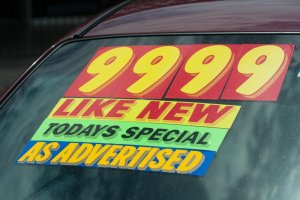If you’re considering buying a used car, you know that there’s not much inventory, right now. Between supply chain pinches and worker shortages around the country, the market has narrowed considerably. Today, used car buyers are facing more competition –and more pressure– than ever.
As a result, it’s essential to do your due diligence. Before you sign on the dotted line and hand over your hard-earned cash, you’ve got to know what to look for in a used car.
In this post, we’ll discuss the main points of a used car inspection, and what to evaluate before you buy – right down to the brakes and tires.
Let’s dive in.
How to Evaluate a Used Car: 5 Professional Tips
The next time you go to view a used car, use these five tips to determine the quality of the vehicle:
1. Read the window sticker
First things first – check out the window sticker attached to the vehicle. The Federal Trade Commission (FTC) requires used car dealers to include a Buyer’s Guide in every used vehicle on their lot. This guide contains important information about the vehicle, including warranty details and the percentage of the repair costs dealers are obligated to pay.
If you decide to purchase the car and there is contrary language in your sales contract, the Buyer’s Guide overrides the information in your purchase agreement.
2. Do a careful inspection of the car
Next, do a careful preliminary inspection of the vehicle. Here are a few things to evaluate:
- The car’s exterior. Check out the condition of the body, taking note of rust, dents, and scratches. Open and close all doors, windows, and the trunk.
- Glass. Look for cracks, dented areas, or chips in the glass. While a small stone chip isn’t cause for concern, significant cracking in the glass is.
- Tires. The wear should be even across all four tires, and the tires should be in generally good condition. Remember that tires must have at least 1/16” of intact tread to be considered legal.
- Interior. The interior of the car should be clean, fresh-smelling, and stain-free, with no tears in or damage to the upholstery.
3. Take it to your mechanic
If the car passes your initial visual inspection, take it to your mechanic. Reputable dealers will lend you the car for the day as long as you provide valid identification. If the salesperson says you don’t need an independent assessment because their in-house shop has already looked it over, insist.
Mechanics generally charge between $100-$150 for a used car inspection. This critical step can help you identify issues that have been glossed-over or deliberately concealed by the dealer. Your mechanic will check the car’s brakes, tires, and engine, and take a look at any available maintenance record. A VERY important step when buying a used car!
When the inspection is over, ask the mechanic to provide you with a written report, which you can use to negotiate with the dealer, if needed.
Pensacola: We’re Your Trusted Partner in Buying a Used Car
You deserve the peace of mind that comes with knowing you made a good investment. If you’re purchasing a used vehicle, come to DeBroux Automotive for a comprehensive used car inspection.
Our Pensacola-based team will evaluate the vehicle’s systems and identify any problems or areas of concern that could cost you down the road.
Ready to learn more? Contact us today.
